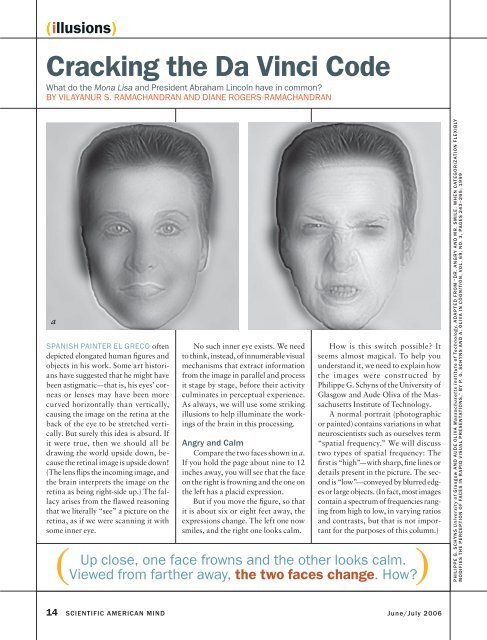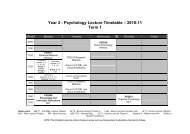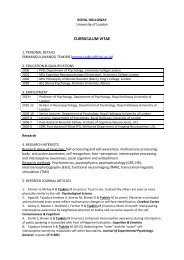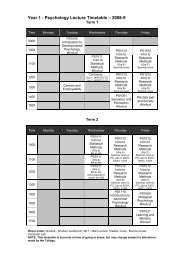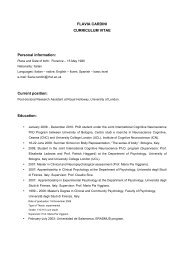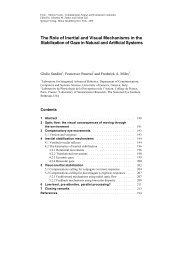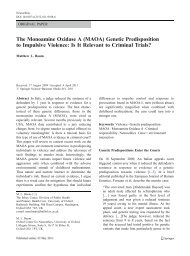Cracking the Da Vinci Code
Cracking the Da Vinci Code
Cracking the Da Vinci Code
You also want an ePaper? Increase the reach of your titles
YUMPU automatically turns print PDFs into web optimized ePapers that Google loves.
(illusions)<br />
<strong>Cracking</strong> <strong>the</strong> <strong>Da</strong> <strong>Vinci</strong> <strong>Code</strong><br />
What do <strong>the</strong> Mona Lisa and President Abraham Lincoln have in common<br />
BY VILAYANUR S. RAMACHANDRAN AND DIANE ROGERS-RAMACHANDRAN<br />
a<br />
SPANISH PAINTER EL GRECO often<br />
depicted elongated human figures and<br />
objects in his work. Some art historians<br />
have suggested that he might have<br />
been astigmatic—that is, his eyes’ corneas<br />
or lenses may have been more<br />
curved horizontally than vertically,<br />
causing <strong>the</strong> image on <strong>the</strong> retina at <strong>the</strong><br />
back of <strong>the</strong> eye to be stretched vertically.<br />
But surely this idea is absurd. If<br />
it were true, <strong>the</strong>n we should all be<br />
drawing <strong>the</strong> world upside down, because<br />
<strong>the</strong> retinal image is upside down!<br />
(The lens flips <strong>the</strong> incoming image, and<br />
<strong>the</strong> brain interprets <strong>the</strong> image on <strong>the</strong><br />
retina as being right-side up.) The fallacy<br />
arises from <strong>the</strong> flawed reasoning<br />
that we literally “see” a picture on <strong>the</strong><br />
retina, as if we were scanning it with<br />
some inner eye.<br />
No such inner eye exists. We need<br />
to think, instead, of innumerable visual<br />
mechanisms that extract information<br />
from <strong>the</strong> image in parallel and process<br />
it stage by stage, before <strong>the</strong>ir activity<br />
culminates in perceptual experience.<br />
As always, we will use some striking<br />
illusions to help illuminate <strong>the</strong> workings<br />
of <strong>the</strong> brain in this processing.<br />
Angry and Calm<br />
Compare <strong>the</strong> two faces shown in a.<br />
If you hold <strong>the</strong> page about nine to 12<br />
inches away, you will see that <strong>the</strong> face<br />
on <strong>the</strong> right is frowning and <strong>the</strong> one on<br />
<strong>the</strong> left has a placid expression.<br />
But if you move <strong>the</strong> figure, so that<br />
it is about six or eight feet away, <strong>the</strong><br />
expressions change. The left one now<br />
smiles, and <strong>the</strong> right one looks calm.<br />
How is this switch possible It<br />
seems almost magical. To help you<br />
understand it, we need to explain how<br />
<strong>the</strong> images were constructed by<br />
Philippe G. Schyns of <strong>the</strong> University of<br />
Glasgow and Aude Oliva of <strong>the</strong> Massachusetts<br />
Institute of Technology.<br />
A normal portrait (photographic<br />
or painted) contains variations in what<br />
neuroscientists such as ourselves term<br />
“spatial frequency.” We will discuss<br />
two types of spatial frequency: The<br />
first is “high”—with sharp, fine lines or<br />
details present in <strong>the</strong> picture. The second<br />
is “low”—conveyed by blurred edges<br />
or large objects. (In fact, most images<br />
contain a spectrum of frequencies ranging<br />
from high to low, in varying ratios<br />
and contrasts, but that is not important<br />
for <strong>the</strong> purposes of this column.)<br />
(<br />
Up close, one face frowns and <strong>the</strong> o<strong>the</strong>r looks calm.<br />
)<br />
Viewed from far<strong>the</strong>r away, <strong>the</strong> two faces change. How<br />
PHILIPPE G. SCHYNS University of Glasgow AND AUDE OLIVA Massachusetts Institute of Technology, ADAPTED FROM “DR. ANGRY AND MR. SMILE: WHEN CATEGORIZATION FLEXIBLY<br />
MODIFIES THE PERCEPTION OF FACES IN RAPID VISUAL PRESENTATIONS,” BY P. G. SCHYNS AND A. OLIVA IN COGNITION, VOL. 69, NO. 3, PAGES 243–265; 1999<br />
14 SCIENTIFIC AMERICAN MIND June/July 2006
(<br />
Squint, and <strong>the</strong> image blurs, eliminating <strong>the</strong> sharp edges.<br />
)<br />
Presto! Lincoln becomes instantly recognizable.<br />
REPRINTED WITH PERMISSION OF LUCENT TECHNOLOGIES, INC./BELL LABS (b); GALA CONTEMPLATING THE MEDITERRANEAN SEA WHICH AT TWENTY METRES BECOMES THE PORTRAIT<br />
OF ABRAHAM LINCOLN (HOMAGE TO ROTHKO); MUSEO DALÍ/BRIDGEMAN ART LIBRARY; © 2006 SALVADOR DALÍ, GALA-SALVADOR DALÍ FOUNDATION/ARS, NEW YORK (c )<br />
Using computer algorithms,<br />
we can process a<br />
normal portrait to remove<br />
ei<strong>the</strong>r high or low spatial<br />
frequencies. For instance, if<br />
we remove high frequencies,<br />
we get a blurred image that<br />
is said to contain “low spatial<br />
frequencies in <strong>the</strong> Fourier<br />
space.” (This ma<strong>the</strong>matical<br />
description need not<br />
concern us fur<strong>the</strong>r here.) In<br />
o<strong>the</strong>r words, this procedure<br />
of blurring is called low-pass<br />
filtering, because it filters out<br />
<strong>the</strong> high spatial frequencies<br />
(sharp edges or fi ne lines)<br />
and lets through only low<br />
frequencies. High-pass filtering,<br />
<strong>the</strong> opposite procedure,<br />
retains sharp edges and outlines<br />
but removes large-scale<br />
variations. The result looks<br />
a bit like an outline drawing<br />
without shading.<br />
These types of computerprocessed<br />
images are com-<br />
c<br />
bined toge<strong>the</strong>r, in an atypical<br />
manner, to create <strong>the</strong> mysterious<br />
faces shown in a. The researchers began<br />
with normal photographs of three<br />
faces: one calm, one angry and one<br />
smiling. They filtered each face to obtain<br />
both high-pass (containing sharp,<br />
fine lines) and low-pass (blurred, so as<br />
to capture large-scale luminance variations)<br />
images. They <strong>the</strong>n combined<br />
<strong>the</strong> high-pass calm face with <strong>the</strong> lowpass<br />
smiling face to obtain <strong>the</strong> left image.<br />
For <strong>the</strong> right image, <strong>the</strong>y overlaid<br />
<strong>the</strong> high-pass frowning face with <strong>the</strong><br />
low-pass calm face.<br />
What happens when <strong>the</strong> figures are<br />
viewed close-up And why do <strong>the</strong> expressions<br />
change when you move <strong>the</strong><br />
page away To answer <strong>the</strong>se questions,<br />
we need to tell you two more things<br />
about visual processing. First, <strong>the</strong> image<br />
needs to be close for you to see <strong>the</strong><br />
sharp features. Second, sharp features,<br />
when visible, “mask”—or deflect attention<br />
away from—<strong>the</strong> large-scale objects<br />
(low spatial frequencies).<br />
So when you bring <strong>the</strong> picture near,<br />
<strong>the</strong> sharp features become more visible,<br />
masking <strong>the</strong> coarse features. As a<br />
result, <strong>the</strong> face on <strong>the</strong> right looks like<br />
it is frowning and <strong>the</strong> one on <strong>the</strong> left,<br />
like it is relaxed. You simply do not<br />
notice <strong>the</strong> opposite emotions that <strong>the</strong><br />
low spatial frequencies convey. Then,<br />
when you move <strong>the</strong> page far<strong>the</strong>r away,<br />
your visual system is no longer able to<br />
resolve <strong>the</strong> fine details. So <strong>the</strong> expression<br />
conveyed by <strong>the</strong>se fi ne features<br />
disappears, and <strong>the</strong> expression conveyed<br />
by low frequencies is unmasked<br />
and perceived.<br />
The experiment shows vividly an<br />
idea originally postulated by Fergus<br />
Campbell and John Robson of <strong>the</strong><br />
University of Cambridge: information<br />
b<br />
from different spatial scales<br />
is extracted in parallel by<br />
various neural channels,<br />
which have wide ranges of<br />
receptive field sizes. (The<br />
receptive field of a visual<br />
neuron is <strong>the</strong> part of <strong>the</strong> visual<br />
field and corresponding<br />
tiny patch of retina to<br />
which a stimulus needs to<br />
be presented to activate it.)<br />
It also shows that <strong>the</strong> channels<br />
do not work in isolation<br />
from one ano<strong>the</strong>r. Ra<strong>the</strong>r <strong>the</strong>y<br />
interact in interesting ways (for example,<br />
<strong>the</strong> sharp edges picked up by small<br />
receptive fields mask <strong>the</strong> blurred largescale<br />
variations signaled by large receptive<br />
fields).<br />
Honest Abe<br />
Experiments of this kind go back<br />
to <strong>the</strong> early 1960s, when Leon Harmon,<br />
<strong>the</strong>n working at Bell Laboratories,<br />
devised <strong>the</strong> famous Abraham<br />
Lincoln effect. Harmon produced <strong>the</strong><br />
picture of Honest Abe (b) by taking a<br />
regular picture and digitizing it into<br />
coarse pixels (picture elements). Even<br />
when viewed close-up, <strong>the</strong>re is enough<br />
information in <strong>the</strong> blocky brightness<br />
variations to recognize Lincoln. But<br />
<strong>the</strong>se data, as we noted already, are<br />
masked by <strong>the</strong> sharp edges of <strong>the</strong> pixels.<br />
When you move far away from <strong>the</strong><br />
www.sciammind.com SCIENTIFIC AMERICAN MIND 15
(illusions)<br />
( )<br />
The elusive smile can be seen only when you look away<br />
from <strong>the</strong> mouth. Attend to it out of <strong>the</strong> corner of your eye.<br />
d<br />
photograph or squint, <strong>the</strong> image blurs,<br />
eliminating <strong>the</strong> sharp edges. Presto!<br />
Lincoln becomes instantly recognizable.<br />
The great artist Salvador <strong>Da</strong>lí<br />
was sufficiently inspired by this illusion<br />
to use it as a basis for his paintings,<br />
an unusual juxtaposition of art<br />
and science (c).<br />
Mysterious Mona Lisa<br />
Finally, consider <strong>the</strong> mysterious<br />
smile of Leonardo da <strong>Vinci</strong>’s Mona<br />
Lisa. Philosophers and art historians<br />
who specialize in aes<strong>the</strong>tics often refer<br />
to her expression as “enigmatic” or<br />
“elusive,” mainly because <strong>the</strong>y do not<br />
understand it. Indeed, we wonder<br />
whe<strong>the</strong>r <strong>the</strong>y prefer not to understand<br />
it, because <strong>the</strong>y seem to resent any attempts<br />
to explain it scientifically, apparently<br />
for fear that such analysis<br />
might detract from its beauty.<br />
But recently neurobiologist Margaret<br />
Livingstone of Harvard Medical<br />
School made an intriguing observation;<br />
she cracked <strong>the</strong> da <strong>Vinci</strong> code,<br />
you might say. She noticed that when<br />
she looked directly at Mona Lisa’s<br />
mouth (d, center panel), <strong>the</strong> smile was<br />
not apparent (quite a disappointment).<br />
Yet as she moved her gaze away<br />
from <strong>the</strong> mouth, <strong>the</strong> smile appeared,<br />
beckoning her eyes back. Looking<br />
again at <strong>the</strong> mouth, she saw that <strong>the</strong><br />
smile disappeared again. In fact, she<br />
noted, <strong>the</strong> elusive smile can be seen<br />
only when you look away from <strong>the</strong><br />
mouth. You have to attend to it out of<br />
<strong>the</strong> corner of your eye, ra<strong>the</strong>r than fixating<br />
on it directly. Because of <strong>the</strong><br />
unique shading (placement of low<br />
spatial frequencies) at <strong>the</strong> corners of<br />
<strong>the</strong> mouth, a smile is perceived only<br />
when <strong>the</strong> low spatial frequencies are<br />
dominant—that is, when you look indirectly<br />
at <strong>the</strong> masterpiece.<br />
To confi rm this notion, she performed<br />
a low-pass filtering (left panel)<br />
and a high-pass filtering (right panel)<br />
of <strong>the</strong> Mona Lisa. Notice that with<br />
<strong>the</strong> low-pass (blurred) image <strong>the</strong> smile<br />
is more obvious than in <strong>the</strong> original—<br />
it can be seen even if you look directly<br />
at <strong>the</strong> mouth. With <strong>the</strong> high-pass (outlinelike)<br />
image, however, no smile is<br />
apparent, even if you look away from<br />
<strong>the</strong> mouth. Putting <strong>the</strong>se two images<br />
(Fur<strong>the</strong>r Reading)<br />
back toge<strong>the</strong>r restores <strong>the</strong> original<br />
masterpiece and <strong>the</strong> elusive nature of<br />
<strong>the</strong> smile. As with <strong>the</strong> changing faces,<br />
we can now better appreciate what<br />
Leonardo seems to have stumbled on<br />
and fallen in love with—a portrait<br />
that seems alive because its fleeting<br />
expression (thanks to quirks of our<br />
visual system) perpetually tantalizes<br />
<strong>the</strong> viewer.<br />
Taken collectively, <strong>the</strong>se experiments<br />
show that <strong>the</strong>re is more to perception<br />
than what meets <strong>the</strong> eye. More<br />
specifically, <strong>the</strong>y demonstrate that information<br />
at different scales, such as<br />
fine versus coarse, may be extracted<br />
initially from an image by separate<br />
neural channels and recombined at<br />
different stages of processing to create<br />
<strong>the</strong> final impression of a single unified<br />
picture in your mind. M<br />
VILAYANUR S. RAMACHANDRAN and<br />
DIANE ROGERS-RAMACHANDRAN are at<br />
<strong>the</strong> Center for Brain and Cognition at <strong>the</strong><br />
University of California, San Diego.<br />
◆ Dr. Angry and Mr. Smile: When Categorization Flexibly Modifies <strong>the</strong> Perception<br />
of Faces in Rapid Visual Presentations. Philippe G. Schyns and Aude Oliva in Cognition,<br />
Vol. 69, No. 3, pages 243–265; 1999.<br />
MARGARET LIVINGSTONE Harvard Medical School<br />
16 SCIENTIFIC AMERICAN MIND June/July 2006


